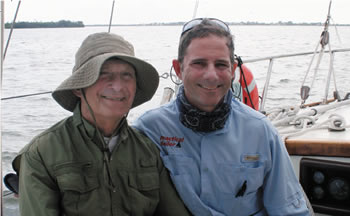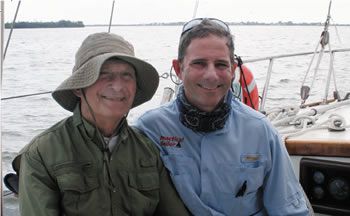
Last summer, I asked my father to join me and my two boys for an overnight passage to the Keys. At the last minute, he decided not to go. Too unsteady on his feet anymore, he said. So you will understand, as I try to explain how sailing-especially around Fathers Day-stirs up mixed emotions.
When I was young, I rarely listened to my father, and when I did, I usually misunderstood. But strangely (for my father is so full of contradictions), he would not have wanted it any other way. He also ignored his father, many times. And so on, down the line.
For the last 50 years, our cultures sense of what it means to be a father has been dramatically shifting underfoot. The role seems so overwhelmingly broad and vaguely defined that some measure of failure is the only sure result. I have failed as a father, many times. But like anything else, those failures-if regarded safely from a distance-offer a mote of wisdom. We can learn from our mistakes.
Fatherhood, no matter how drastically the definition has changed over the years, remains an exercise in restraint. My father taught me this. And I can’t think of any better place to learn this lesson than where he taught me: on the water, in a boat.
The art of giving your son or daughter enough confidence to take the helm is far easier said than done. I know. Neither of my sons is very keen to sail, and I realize, to some degree, I am to blame. Step in too frequently or too soon, and the lesson wont sink in; too late, and he or she may never sail again.
Sailing is more complex than it appears at the surface. Instilling true confidence requires a delicate balance. But the real test of a father comes later, when confidence is not the problem-just the opposite. The damn kid thinks hes invincible.
I was two years out of college when I told my father I was quitting a good job to sail around the world in an old wooden boat. Although Im sure his head reeled with doubts, his reaction was inscrutable: It sounds like an adventure, he said. He probably realized that hed brought this on himself.
When I was 12 years old, we chartered a Gulfstar 41 in the Virgin Islands. On passage between Cooper Island and Virgin Gorda, a strong easterly hummed in the rigging, and for the first time on the trip, the boat rose and fell over a long swell. It was exhilarating and a little frightening as the hull lifted and then disappeared down the back of each wave. But in my fathers presence, I knew there was no reason to be nervous. It was sunny. The sky was clear.
After an hour of close reaching into the swell, my father bore off to a broad reach. The boat picked up speed and a line of white foam stretched in our wake. It was at that moment that he said something that I still hope I can manage to say-with the same authority, and the same effect-to my own two sons.
You want to take the wheel?
He never again asked to take it back.








































